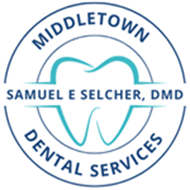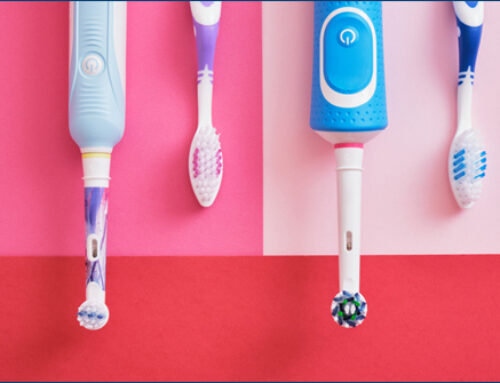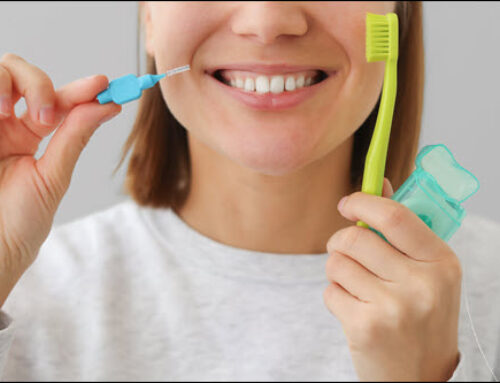Brushing, flossing, and rinsing protect teeth and gums from cavities and gum disease. Proper oral care strengthens enamel, reduces plaque, and improves breath freshness. Brushing removes plaque from tooth surfaces, while flossing cleans between teeth and under the gumline. Rinsing with mouthwash reduces bacteria and strengthens enamel. Poor oral hygiene increases the risk of cavities, gum inflammation, and tooth sensitivity. Consistent brushing, flossing, and rinsing create a balanced and healthy smile. Proper technique improves gum health and prevents plaque buildup. Understanding how to brush, floss, and rinse properly strengthens overall dental health. Let’s explore how these three steps improve your smile and protect your teeth.
Brushing to Remove Plaque and Strengthen Enamel
Brushing removes plaque, bacteria, and food particles from tooth surfaces. Use a soft-bristled toothbrush and fluoride toothpaste. Hold the toothbrush at a 45-degree angle to the gumline. Use small, circular motions to clean all tooth surfaces. Clean the front, back, and chewing surfaces of each tooth. Brush for at least two minutes, twice a day. Avoid brushing too hard to prevent enamel wear and gum irritation. Clean the tongue and roof of the mouth to remove bacteria. Replace your toothbrush every three months or when bristles fray. Electric toothbrushes improve plaque removal and increase brushing efficiency. Proper brushing strengthens enamel and reduces plaque buildup.
Choosing the Right Toothbrush and Toothpaste
A soft-bristled toothbrush protects enamel and gums from damage. Hard-bristled brushes increase gum recession and enamel erosion. Electric toothbrushes provide more consistent pressure and improve plaque removal. Fluoride toothpaste strengthens enamel and protects against acid damage. Anti-cavity toothpaste reduces tooth decay and increases enamel resistance. Desensitizing toothpaste reduces discomfort from hot, cold, and sweet foods. Whitening toothpaste removes surface stains and brightens enamel. Antibacterial toothpaste reduces plaque and gum inflammation. Dentists recommend using a pea-sized amount of toothpaste. Proper brushing tools increase comfort and improve dental health. The right toothbrush and toothpaste increase overall dental protection and strength.
Flossing to Clean Between Teeth
Flossing removes plaque and food particles from between teeth and under the gumline. Use about 18 inches of floss, wrapping it around your middle fingers. Slide the floss gently between teeth using a back-and-forth motion. Curve the floss into a “C” shape around each tooth. Clean under the gumline without snapping the floss to avoid gum damage. Use a clean section of floss for each tooth to prevent bacteria transfer. Water flossers and floss picks provide alternative methods for tight spaces. Flossing reduces plaque buildup and improves gum health. Clean gumlines increase tooth stability and reduce sensitivity. Stronger gums improve bite strength and overall dental health.
Why Flossing Is Essential for Gum Health
 Flossing removes plaque from areas that brushing misses. Plaque buildup between teeth increases cavity and gum disease risk. Flossing reduces gum inflammation and prevents gum recession. Clean gumlines improve gum attachment and tooth stability. Regular flossing reduces bleeding and sensitivity while brushing. Flossing prevents tartar formation and strengthens gum health. Water flossers improve plaque removal for patients with braces or dental work. Flossing once a day improves gum health and reduces bad breath. Stronger gum attachment improves tooth stability and bite strength. Regular flossing improves overall dental health and increases chewing comfort. Better flossing habits create a healthier and more balanced smile.
Flossing removes plaque from areas that brushing misses. Plaque buildup between teeth increases cavity and gum disease risk. Flossing reduces gum inflammation and prevents gum recession. Clean gumlines improve gum attachment and tooth stability. Regular flossing reduces bleeding and sensitivity while brushing. Flossing prevents tartar formation and strengthens gum health. Water flossers improve plaque removal for patients with braces or dental work. Flossing once a day improves gum health and reduces bad breath. Stronger gum attachment improves tooth stability and bite strength. Regular flossing improves overall dental health and increases chewing comfort. Better flossing habits create a healthier and more balanced smile.
Rinsing to Kill Bacteria and Improve Breath
Rinsing with mouthwash reduces bacteria and freshens breath. Antibacterial mouthwash reduces plaque and gum inflammation. Pour about 20 milliliters of mouthwash into a cup. Swish it around your mouth for 30 to 60 seconds. Gargle to clean the back of the throat and remove bacteria. Spit out the mouthwash and avoid rinsing with water afterward. Alcohol-free mouthwash prevents dry mouth and reduces gum irritation. Fluoride-based mouthwash strengthens enamel and reduces sensitivity. Rinsing after brushing and flossing improves overall mouth cleanliness. Proper rinsing reduces plaque buildup and strengthens tooth protection. Better mouthwash use improves breath freshness and overall dental health.
Choosing the Right Mouthwash
Fluoride mouthwash strengthens enamel and protects against cavities. Antiseptic mouthwash reduces plaque and gum inflammation. Alcohol-free mouthwash prevents dry mouth and gum irritation. Mouthwash with essential oils improves breath freshness and bacterial control. Antibacterial mouthwash reduces plaque buildup and gum disease risk. Whitening mouthwash removes surface stains and brightens teeth. Sensitivity-reducing mouthwash protects enamel and improves comfort. Dentists recommend using mouthwash after brushing and flossing. Rinsing twice a day improves overall dental strength and protection. Choosing the right mouthwash increases long-term dental health and breath quality. Stronger enamel and cleaner gums improve overall comfort and smile strength.
Combining Brushing, Flossing, and Rinsing for Best Results
Brushing, flossing, and rinsing work together to improve dental health. Brushing removes surface plaque and strengthens enamel. Flossing removes hidden plaque and reduces gum inflammation. Rinsing kills bacteria and freshens breath. Consistent care reduces plaque buildup and gum disease risk. Stronger enamel resists cavities and improves bite strength. Clean gumlines improve tooth stability and reduce sensitivity. Daily care prevents tartar formation and strengthens gum attachment. Proper oral care reduces the need for complex dental treatments. Professional cleanings every six months improve overall dental health. Consistent brushing, flossing, and rinsing strengthen teeth and create a balanced smile.
Preventing Dental Problems with Daily Care
Consistent oral care reduces the risk of cavities and gum disease. Proper brushing, flossing, and rinsing strengthen enamel and protect gum tissue. Reduced plaque buildup prevents gum inflammation and tooth sensitivity. Fluoride toothpaste strengthens enamel and reduces acid damage. Antibacterial mouthwash improves breath freshness and plaque control. Professional cleanings detect early signs of cavities and gum disease. Better oral care reduces the need for fillings and deep cleanings. Stronger teeth increase chewing comfort and overall bite strength. Clean gums improve tooth stability and reduce recession risk. Regular care creates a healthier, more confident smile.
Maintaining a Healthy Routine
Establishing a daily routine strengthens long-term dental health. Brush twice a day using proper technique and fluoride toothpaste. Floss once a day to remove plaque and food particles. Rinse with mouthwash to reduce bacteria and freshen breath. Replace your toothbrush every three months or when bristles fray. Schedule professional cleanings every six months to improve dental strength. Regular care increases gum health and reduces cavity risk. Healthy habits increase enamel strength and bite comfort. Consistency improves both dental health and smile confidence. A balanced routine creates a brighter and more comfortable smile.
Brushing, flossing, and rinsing protect teeth and gums from cavities, plaque, and gum disease. Brushing strengthens enamel and removes surface plaque. Flossing reduces gum inflammation and improves tooth stability. Rinsing kills bacteria and improves breath freshness. Proper technique increases enamel strength and gum health. Professional cleanings detect early signs of cavities and gum disease. Establishing a consistent routine strengthens teeth and improves overall comfort. Investing in better oral care increases confidence and smile strength. Stronger teeth and healthier gums improve bite efficiency and comfort. A balanced, clean smile increases both dental health and personal confidence.



